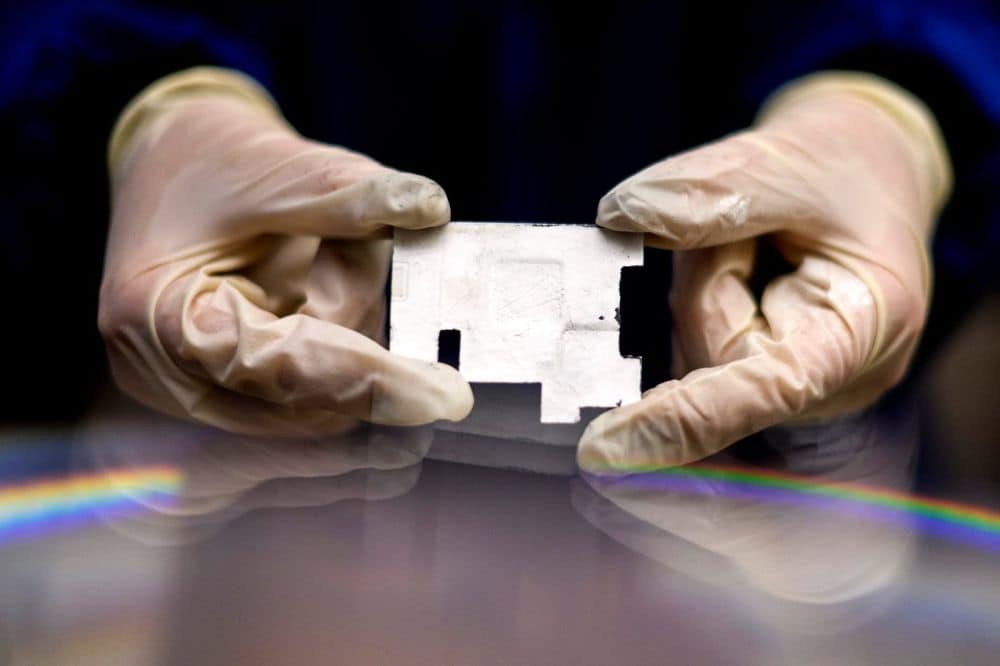
[Image above] Example of a new boron-based ceramic matrix composite that can be thermoformed into complex parts, for example, heat spreaders for printed circuit boards. Credit: Matthew Modoono, Northeastern University
While brittleness is traditionally viewed as a core characteristic of ceramics, research on dislocations in ceramics, which blossomed in recent decades, revealed that ceramics can plastically deform given the proper conditions. This realization opens new pathways to forming and applying ceramics in devices.
In a recent paper, Northeastern University (Boston, Mass.) researchers demonstrate how one condition—a material’s microstructure—was key to forming ceramics via a method traditionally reserved for plastics and sheet metals.
As explained in a Northeastern University press release, associate professor of mechanical and industrial engineering Randall Erb and Ph.D. student Jason Bice made this discovery accidentally when working on a hypersonic project for an industrial partner.
After blasting an experimental ceramic matrix composite (CMC) with a blowtorch, it unexpectedly deformed and fell out of the fixture during loading.
“We looked at the sample on the floor thinking that it was a failure,” Erb says in the press release.
However, examination of the CMC revealed it was still intact, just shaped differently.
Further experiments showed Erb and Bice that the deformation was controllable. This realization led them and colleagues to explore forming the CMC through thermoforming.
Thermoforming is essentially the opposite of injection molding, another well-known manufacturing process. Injection molding involves heating material to a liquid state and injecting it into a mold, where it cools and is subsequently ejected. In contrast, thermoforming involves heating a sheet-shaped material to a pliable temperature and then laying it over a mold using pressure or vacuum forming methods.
While injection molding is often a better choice for manufacturing small, intricate parts and conducting large production runs, thermoforming holds the edge for large-scale designs and shorter production runs.
As discussed on CTT last month, injection molding is a common method for producing ceramic parts. However, the typically brittle nature of ceramics keeps it from being formed via thermoforming methods, as ceramics tend to fracture instead of deform when subjected to extreme heat changes and/or mechanical loading.
In the recent paper, the Northeastern University researchers demonstrate how, with the right material and structure, it is possible to form ceramics via thermoforming.
Their CMC consists of highly oriented hexagonal boron nitride (hBN) particles within a boron oxide matrix. They explain that the atomic structure of hBN gives it high thermal anisotropy, i.e., high thermal conductivity in some directions and low thermal conductivity in other directions. This property allows the CMC to quickly transmit heat and flow effectively during the molding process.
To fully harness this innate property of hBN, the researchers used a vibration-assisted casting method they previously developed to align high volume fractions of hBN particles (60 vol%) in a liquid photoresin. They then subjected the dense particle suspension to vibration energies during a tape casting process to further fluidize and shear align the hBN in-plane to a high degree.
Following tape casting, the researchers applied ultraviolet light to the suspension to polymerize the photoresin, locking in the oriented hBN particles. Finally, they subjected the samples to pressureless sintering in oxygenated environments to grow a matrix of boron oxide that replaced the polymeric matrix and engulfed the hBN.
When the boron-based CMC was heated higher than 450°C, the boron oxide melted and the material behaved as a Bingham pseudoplastic, i.e., it behaves as a rigid body at low stresses but flows as a viscous fluid at high stress.
The researchers characterized the CMC’s flow regimes into a phase diagram and determined the optimal flow properties for thermoforming occurred between 500–700°C. With this knowledge, they thermoformed the boron-based CMC to a variety of molds and feature sizes, achieving feature sizes as small as 200 μm at 700°C.
The potential effect of ceramic thermoforming on the electronics field was the main application area given as an example by the researchers. In general, cellphones and other electronics are fitted with a bulky layer of aluminum, which is necessary to draw heat away from the unit.
“Our material can be less than a millimeter thick, which presents a low-profile solution,” Bice says in the press release. “It can be molded to conform to the surface that you’re trying to cool.”
Additionally, Erb adds that “If you put an aluminum heatsink into an RF [radio frequency] component, you’ve basically introduced a series of antennae to interact with the RF signal. Instead, we can put our boron nitride-based material in and around an RF component and it is essentially invisible to the RF signal.”
They demonstrated this potential by creating a testbed platform with a Raspberry Pi computer, comparing the cooling performance of an incumbent aluminum heat sink against a press-fit, thermoformed CMC. When the heat sinks were normalized by height, the CMC showed a cooling advantage 10× over the aluminum.
According to the press release, Erb and Bice are now developing the thermoformed CMC via their startup, Fourier LLC. They received a $50,000 Spark Fund award from Northeastern’s Center for Research Innovation to support this work.
The paper, published in Advanced Materials, is “Thermoformable boron nitride based all-ceramics” (DOI: 10.1002/adma.202203939).
Author
Lisa McDonald
CTT Categories
- Electronics
- Manufacturing
- Material Innovations


